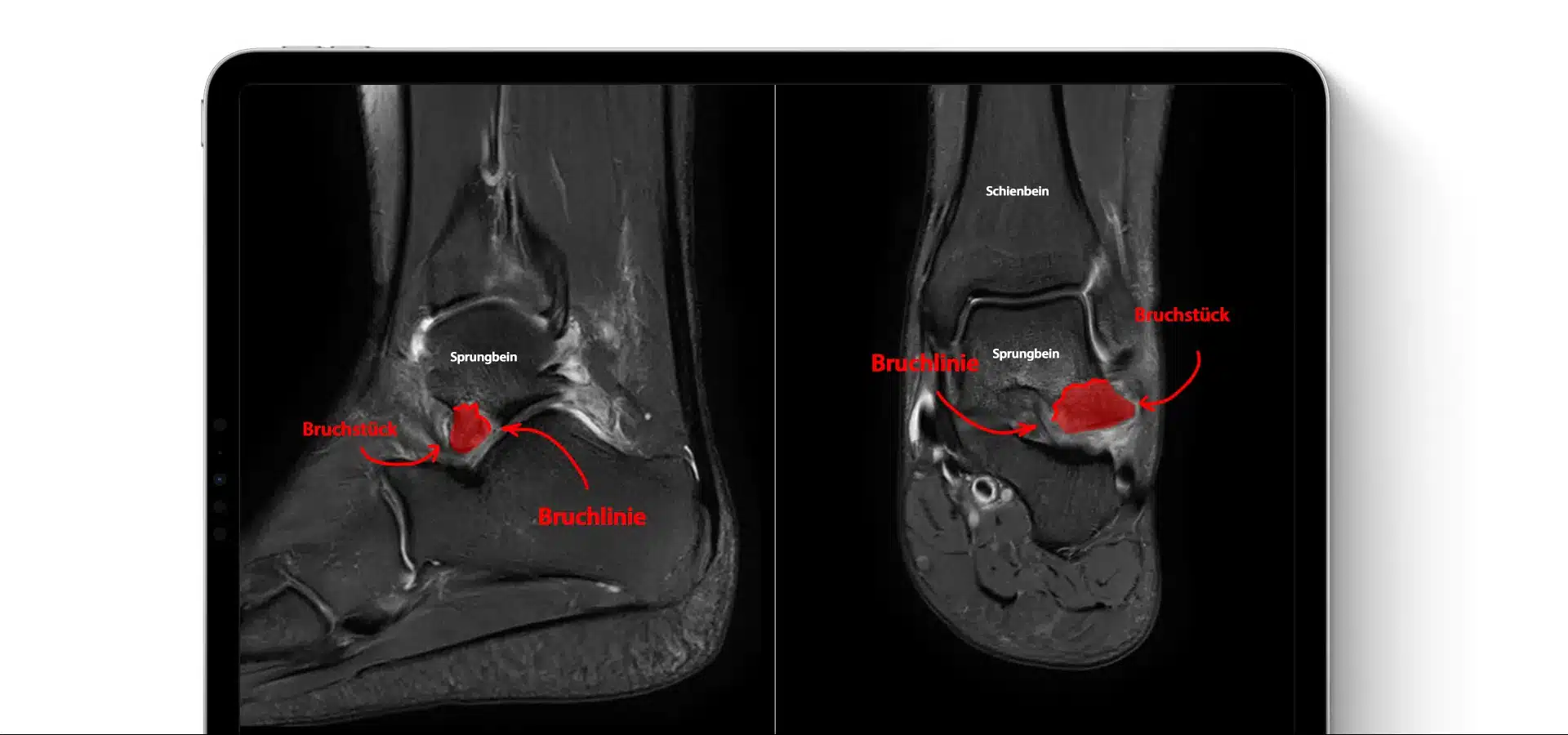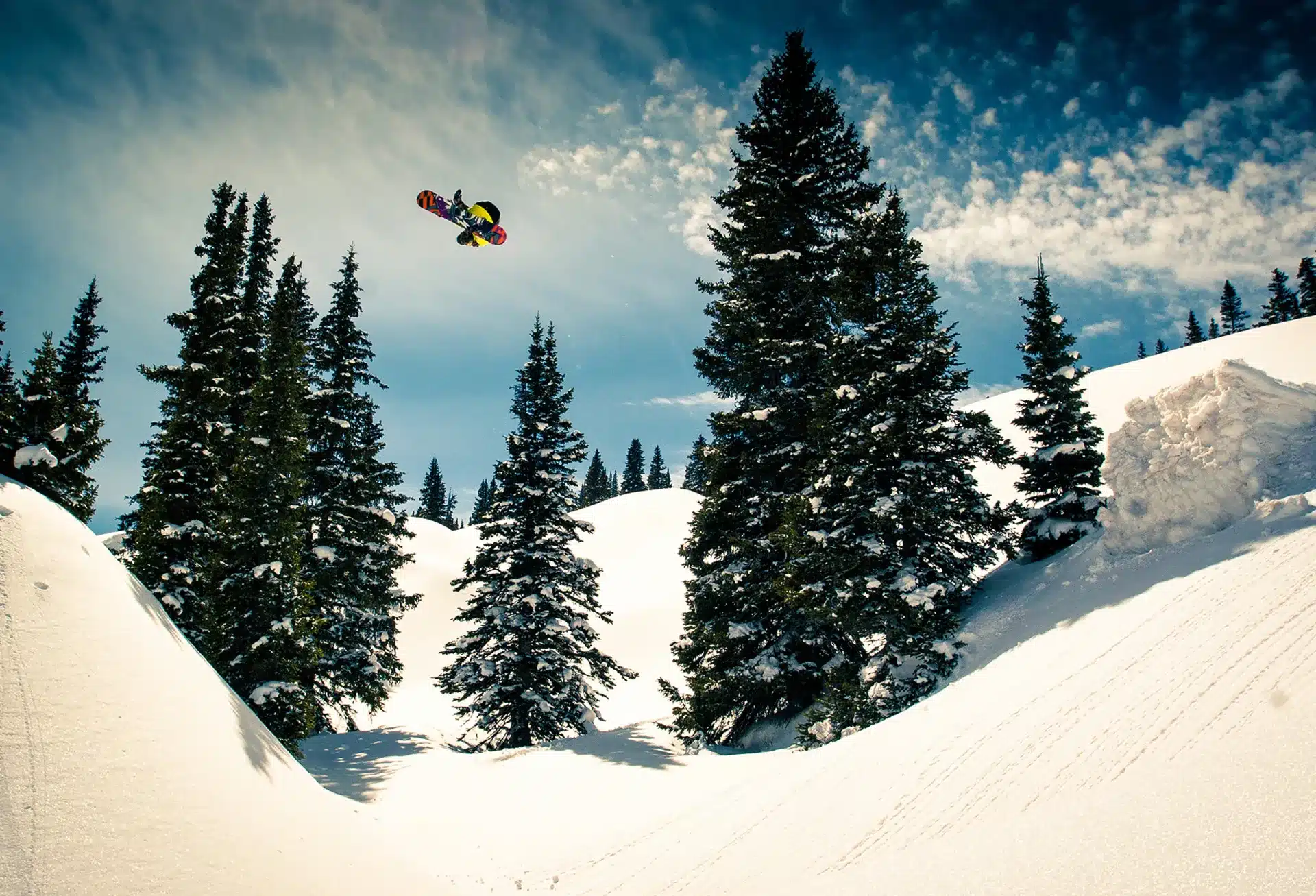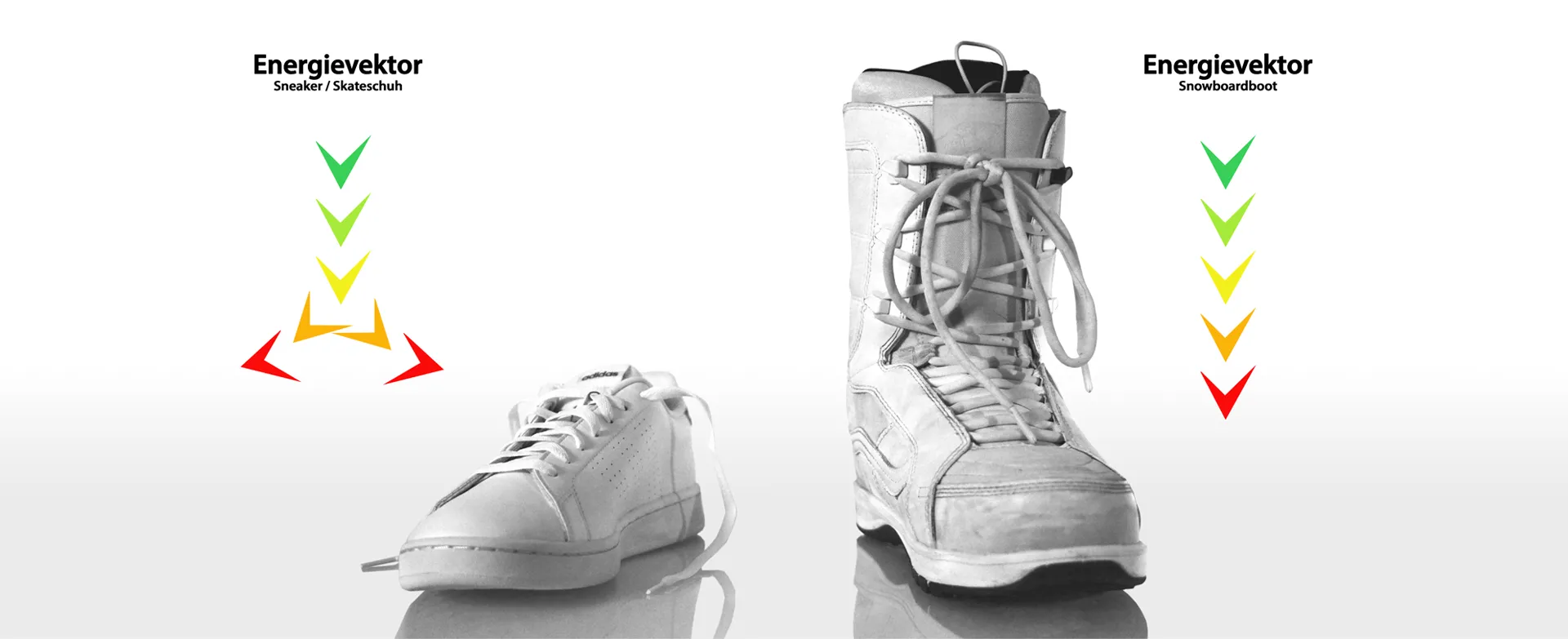Snowboarder's Ankle

Was genau ist das Snowboarder’s Ankle?
Das Snowboarder’s Ankle ist ein Bruch des s.g. Processus lateralis tali (der äußere Fortsatz des Sprungbeins) und wurde bereits im Jahre 1965 in der medizinischen Literatur beschrieben. Auch wenn die Geschichte des Snowboardens weit zurück nach Hawaii mit dem He’ehölua, ins Salzburger Land mit dem Knappenrößl oder in die Türkei mit dem Lazboard geht, ist die Wahrscheinlichkeit für die Entstehung der Fraktur aufgrund der Nutzung der Vorfahren des Snowboards in dieser Zeit sehr gering, denn die Verletzung entsteht typischerweise bei der Landung nach einem Sprung.
Die Erstbeschreibung dieses seltenen Knochenbruchs (1,2% – 6,3% der Brüche der unteren Extremität)
wurde erst Ende der 80er Jahre nach systematischen Analysen der Verletzungen beim Snowboarden und Skifahren mit dem Snowboarden in Verbindung gebracht. Zwischen 1994 und 1996 entstanden die Begriffe „snowboarder’s fracture“ und „snowboarder’s ankle“.
Laut einer Studie aus dem Jahre 1995 waren über 1/3 der Knöchelbrüche bei Snowboardern eine Fraktur des Processus lateralis tali.
Hinweis: der englische Begriff „ankle“ schließt im Gegensatz zum deutschen Begriff „Knöchel“ auch das Sprungbein mit ein.

Entstehung und Ursachen
Der Unfallmechanismus beim Snowboard’s Ankle ist als spezifisch für das Snowboarden anzusehen, denn nur bei dieser Sportart (und Wakeboarden) werden die Sprunggelenke durch die Snowboardboots sowie die Snowboardbindungen in einer Position der Füße bei der Landung, die zwischen 70° und 90° zur Fortbewegungsrichtung beträgt, fixiert. Bei der Landung nach einem Sprung kommt es zu einer großen Krafteinwirkung (axial loading) und bei einer unsauberen Landung zu einer Gewichtsmehrverteilung auf dem vorderen oder hinteren Bein.
Dies führt zu einer s.g. Dorsalextension (Streckung des Fußes und der Zehen in Richtung Fußrücken) sowie zu einer s.g. Eversion (Bewegung des Fußes weg von der neutralen Stellung nach außen). Die straffe Konstruktion der Snowboardboots (auch Softboots sind in der Regel straff genug) verbunden mit der Snowboardbindung sichern das Sprunggelenk, sodass ein klassisches Umknicktrauma (wie z.B. beim Skateboarden) ausbleibt und die axiale (von oben nach unten) Kraft nicht nach innen „ausbrechen“ kann.
Die Kraft wird weiter entlang des Außenknöchels auf den im Snowboardboot fixierten Fuß auf das sich unterhalb des Wadenbeins (Fibula) befindende Sprungbein (Talus) und insbesondere auf den äußeren Fortsatz des Sprungbeins (Processus lateralis tali) übertragen. Bei ausreichender Krafteinwirkung bricht der Knochen an dieser Stelle. Dieser Unfallmechanismus wurde im Jahre 2003 an Kadaverstudien bestätigt.
Die Brüche des Processus lateralis tali können unterschiedlich ausgeprägt sein. Aus diesem Grund wurde bereits im Jahre 1965 eine Einteilung der Brüche angestrebt. Die heutzutage gebräuchlichste Klassifikation der Processus lateralis tali Fraktur ist die nach McCrory und Bladin aus dem Jahr 1996. Diese findet auch bei der Diagnostik des Snowboarder’s Ankle (auch snowboarder’s fracture) Verwendung.

Die drei Typen von Frakturen Klassifikation nach McCrory und Bladin (1996)

Die Klassifikation der Brüche des Processus lateralis tali
hat sich über die Jahre weiterentwickelt.
Die initiale Klassifikation von Hawkins wurde später von McCrory
und Bladin nach Schwere der Verletzung umsortiert:
Typ I
kleiner Abbruch an der Spitze des Fortsatzes (Avulsion)
Typ II
großes einzelnes Knochenfragment
Typ III
ähnliche Ausdehnung der Verletzung wie Typ II, jedoch als
Trümmerbruch (viele kleine Fragmente)

Was ist ein Talus?
Das Sprungbein (lat. Talus) ist ein Knochen der unteren Extremität, der die Last des Körpers vom Unterschenkel auf das subtalare Fußskelett überträgt. Der Talus weist mehrere Verbindungen über Gelenke mit den benachbarten Strukturen auf – mit dem Schien-(Tibia) und Wadenbein (Fibula) im oberen Sprunggelenk, mit dem Fersenbein (Calcaneus), Kahnbein (Os naviculare) und mit dem Pfannenband (Spring ligament) im unteren Sprunggelenk. Der Talus wird in einen Körper, Hals und Kopf unterteilt.
Die Verknöcherung beginnt im Talus in der 28. – 32. Entwicklungswoche mit einem oder zwei Knochenkernen. Als apophysäre Anlage kann sich das s.g. Tuberculum laterale des hinteren Fortsatzes entwickeln. Falls eine knöcherne Verschmelzung mit dem Körper des Sprungbeins ausbleibt, entsteht ein eigenständiges Knöchelchen – das s.g. Os trigonum (bei ca. 6% der Menschen).

Beschwerden und Symptomatik
Die typischen Beschwerden beim Snowboard’s Ankle sind Schmerzen und Schwellung in der Fußwurzel und am Fuß außen. Diese Symptome können leicht mit denen der Verstauchung bzw. des Bänderrisses verwechselt werden. Das gilt sowohl für die betroffene Person als auch für die untersuchenden Ärzt*innen – insbesondere dann, wenn der Unfallhergang nicht bekannt ist.
Die Diagnose kann weiterhin dadurch erschwert werden, dass dieser Bruch auf konventionellen Röntgenaufnahmen manchmal schwer zu erkennen ist. Dies ist der Fall bei kleinen Brüchen (Typ I), die nicht verschoben sind. Die Wahrscheinlichkeit einen Bruch des Processus lateralis tali auf Röntgenbildern zu übersehen, wird in der Literatur mit bis zu 50% angegeben.
Aus diesem Grund wird bei einem klinischen Verdacht auf ein Snowboarder’s Ankle die Schnittbildgebung empfohlen.
Das MRT des Sprunggelenks kann das s.g. Knochenmarködem im Rahmen eines Bruches oder einer Knochenkontusion sehr gut zeigen. Eine Bruchlinie kann jedoch nicht immer gut abgegrenzt werden, sodass die Unterscheidung zwischen Bruch oder einem s.g. subtalaren Impingement schwierig sein kann. Die Computertomographie kann die Bruchlinien ohne Überlagerung am besten darstellen und ist als Untersuchungsmethode der Wahl zu sehen.
Das MRT kann hilfreich sein, begleitende Weichteilverletzungen zu erkennen – z.B. Knorpelschäden, Bänder- und Sehnenrisse.
Was soll ich als
Snowboarder*in beachten?
Das Snowboarder’s Ankle ist eine Verletzung der fortgeschrittenen Snowboarder*innen und entsteht typischerweise nach einer Landung. Wenn du nach einer Snowboard-Session (insb. bei Kickern im Park) Schmerzen am Fußrücken und am Fuß außen hast, nimm das ernst. Auch wenn du sonst z.B. vom Skateboarden solche Schmerzen kennst, tu das nicht als eine Stauchung des Sprunggelenks ab. Lass dich untersuchen und teile den Radiolog*innen mit, dass du Snowboarder*in bist und schonmal vom Snowboarder’s Ankle gehört hast.
Falls du dir unsicher bist, kannst du uns jederzeit kontaktieren!
Behandlung des Snowboarder’s Ankle
Die frühzeitige Erkennung der Verletzung ist besonders wichtig für die Vermeidung von Komplikationen wie einer Pseudarthrose, eines Impingement, einer Knochennekrose oder der posttraumatischen Arthrose. Die Größe der Fraktur und die Anzahl der verschobenen Bruchstücke sind wichtig für die Therapieplanung.
In der Regel werden die kleinen s.g. Avulsionsverletzungen konservativ behandelt mit einer symptomatischen Therapie, kurzzeitiger Immobilisation, gefolgt von Mobilisierung des Gelenks und zunehmender Belastung.
Bei persistierenden Beschwerden nach 6 Monaten kann eine chirurgische Remodellierung des Fortsatzes indiziert sein.
Nicht verschobene Brüche können mit Ruhigstellung ohne Belastung für 4-6 Wochen behandelt werden, gefolgt von Mobilisierung in einer Gehschiene für weitere 2-3 Wochen.
Brüche mit verschobenen Bruchstücken sind problematischer, da sie zu Pseudarthrose führen können, wenn sie nicht chirurgisch versorgt werden. Eine geschlossene Reposition der Fragmente wird als unzureichend angesehen.
Einzelne Bruchstücke, die größer als 1 cm sind oder mehr als 2 mm verschoben sind, sollen chirurgisch reponiert werden. Dies kann mithilfe einer Schraube oder eines s.g. Kirschner-Drahts erfolgen. Kopflose Schrauben wie die Herbert-Schraube können dafür verwendet werden, da diese unterhalb der Gelenkfläche versenkt werden können.
Das Entfernen von größeren oder mehreren Bruchstücken kann zu einer deutlichen Instabilität des unteren Sprunggelenks führen und eine Versteifung (Arthrodese) des Gelenks erforderlich machen. Falls eine posttraumatische Arthrose als Folge der Verletzung entsteht, kann eine Versteifung des Gelenks nötig sein, da das untere Sprunggelenk öfters davon betroffen ist als das obere Sprunggelenk. Es ist sehr selten, dass eine Arthrose zwischen Wadenbein und Sprungbein eine Gelenkversteifung nötig macht.
Die Snowboard-Aufnahmen wurden uns zur Verfügung gestellt von
Quellen:
- G. Hawkins: Fracture of the lateral process of the talus. In: The Journal of bone and joint surgery. American volume. Band 47, September 1965, S. 1170–1175
- C. Pino, M. R. Colville: Snowboard injuries. In: The American journal of sports medicine. Band 17, Nummer 6, 1989 Nov-Dec, S. 778–781
- Nicholas, J. Hadley, C. Paul, P. James: “Snowboarder’s fracture”: fracture of the lateral process of the talus. In: The Journal of the American Board of Family Practice / American Board of Family Practice. Band 7, Nummer 2, 1994 Mar-Apr, S. 130–133
- McCrory, C. Bladin: Fractures of the lateral process of the talus: a clinical review. “Snowboarder’s ankle”. In: Clinical Journal of Sport Medicine . Band 6, Nummer 2, April 1996, S. 124–128
- Miller: Fractures of the Lateral Process of the Talus: Snowboarder’s Fracture. In: PI Update 2008: Chapter 23, S. 119-123
- Bohyn, D. V. Flores, T. Murray, B. Mohr, M. Cresswell: Imaging Review Of Snowboard Injuries. In: Semin Musculoskelet Radiol 2022: 26: 54-68.
- In: Waldeyer Anatomie des Menschen, 17. Auflage, 2003, S. 1106-1108.

